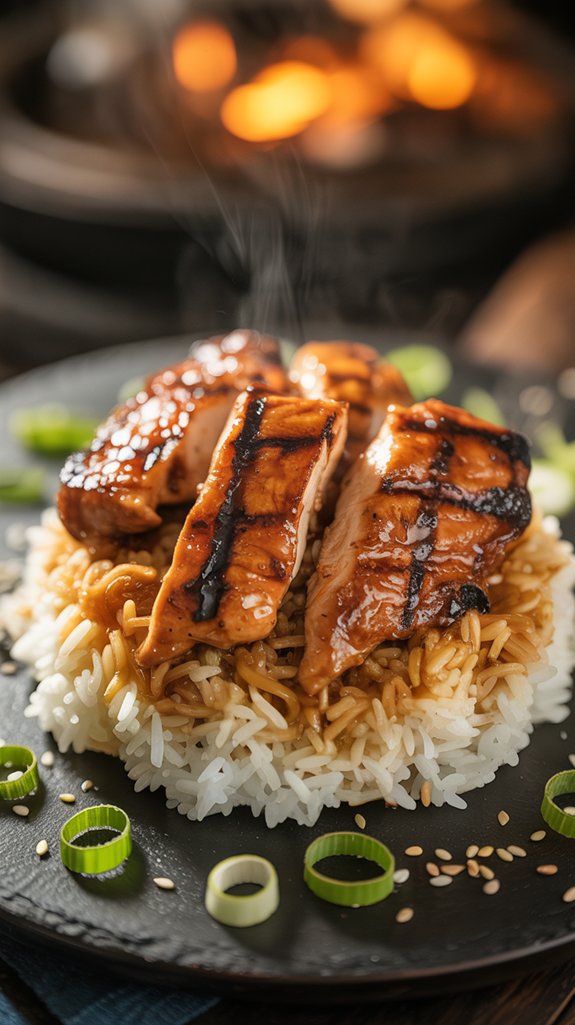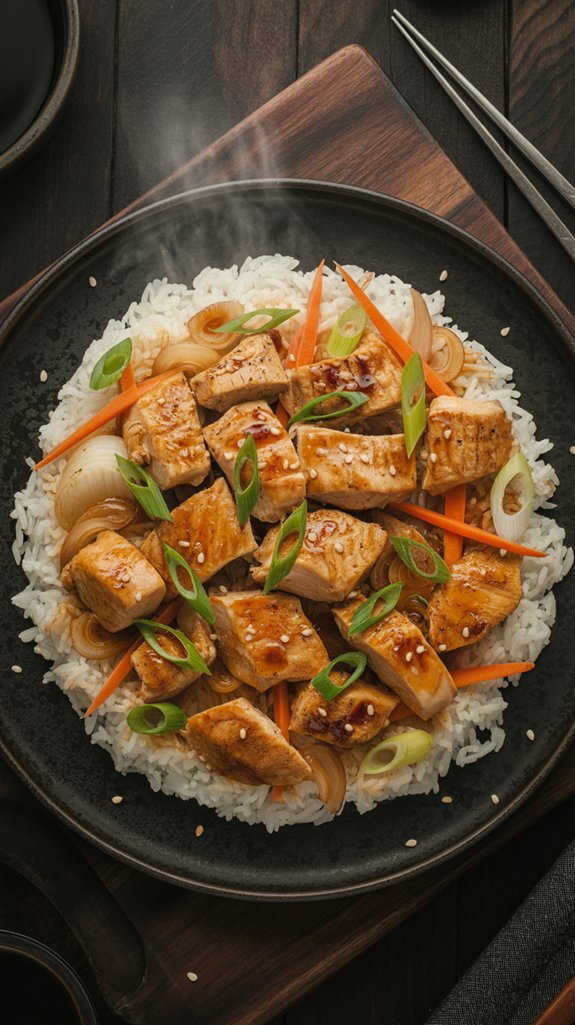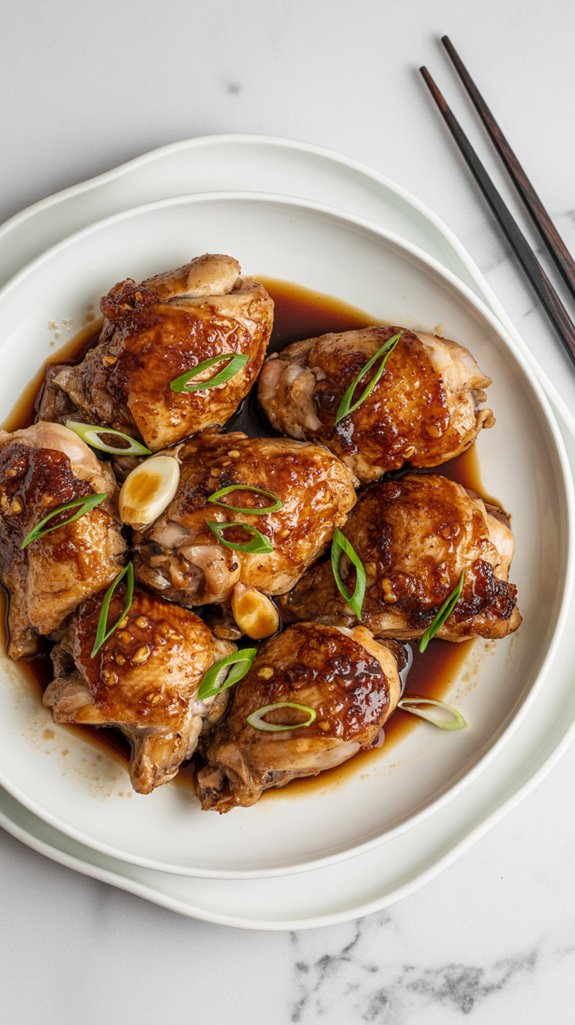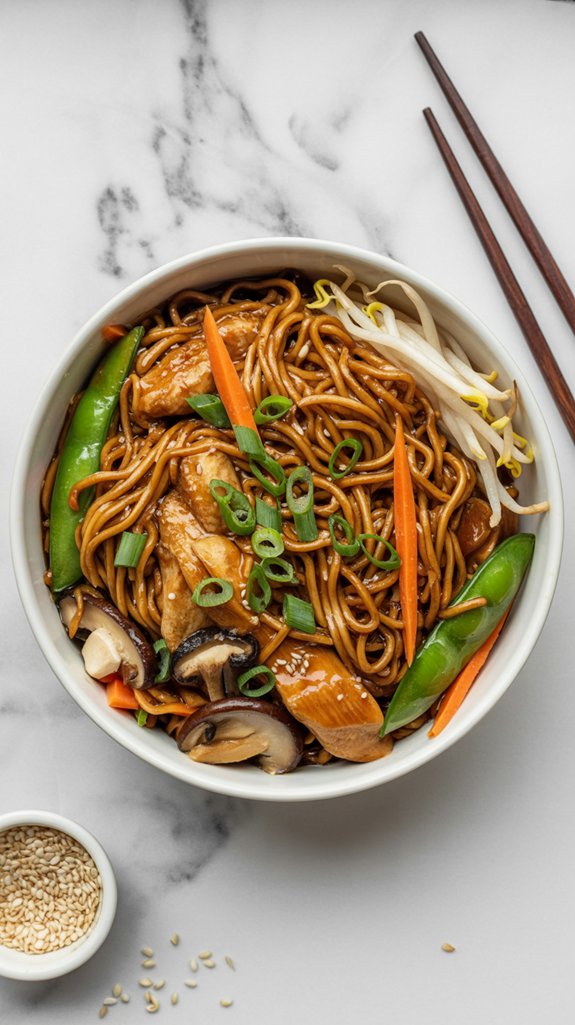Why You’ll Love This this Sizzling Japanese Hibachi Chicken & Rice
This recipe brings all those sizzling hibachi restaurant flavors right to your home kitchen, complete with that buttery, soy-glazed goodness that makes you want to lick the spatula when no one’s looking.
You get tender, bite-sized chicken, perfectly seasoned fried rice, and crispy vegetables all cooked in separate pans just like the pros do, which means everything stays at the perfect texture instead of turning into one mushy mess.
The best part is watching everything come together in about 30 minutes, filling your kitchen with those amazing aromas that’ll have your family hovering around asking “is it ready yet” every five minutes.
Ingredients List
You’ll need just a handful of simple ingredients that you probably already have hanging around your kitchen, plus some fresh chicken and vegetables to make this restaurant-quality hibachi feast.
For the Hibachi Chicken:
- 1-1½ lb chicken breast
- 1 tablespoon vegetable oil
- ½ teaspoon sesame seed oil
- 1 tablespoon butter
- 3 tablespoons soy sauce
- 2 teaspoons fresh lemon juice
- 1 dash salt
- 1 dash pepper
For the Hibachi Vegetables:
- 1 tablespoon vegetable oil
- ½ teaspoon sesame seed oil
- 1 large white onion
- 1 large zucchini
- 1 tablespoon butter
- 2 tablespoons soy sauce
- 1 dash salt
- 1 dash pepper
For the Hibachi Fried Rice:
- 4 cups cooked rice (cooled)
- 2 tablespoons vegetable oil
- ½ cup white onion
- 1 cup bean sprouts
- 2 large eggs
- 4 tablespoons butter
- 4 tablespoons soy sauce
For the Hibachi Bean Sprouts:
- 1 tablespoon butter
- 1 tablespoon soy sauce
- 3 cups bean sprouts
A Few Things Worth Mentioning:
- This recipe packs quite a bit of sodium from all that soy sauce, so if you’re watching your salt intake, you might want to use low-sodium soy sauce or cut back a little on the amounts.
- The butter adds amazing flavor but also bumps up the calories, though you could swap some of it for extra sesame oil if you want to lighten things up.
- Bean sprouts and zucchini bring fiber and vitamins to the party, making this more balanced than your typical takeout order.
- Using brown rice instead of white rice would add more nutrients and fiber, though it won’t taste quite as authentic.
Step by Step Directions

Cook the rice first and let it cool completely while you prepare the other components, as this recipe works best when you can cook multiple elements simultaneously. For an authentic hibachi experience at home, consider using an electric hibachi grill to recreate the traditional Japanese cooking method.
Step 1: Prepare the Hibachi Chicken****
- Cut chicken breast into bite-sized pieces.
- Heat vegetable oil and sesame oil in a large skillet or wok over medium-high heat.
- Add chicken, soy sauce, butter, lemon juice, salt, and pepper to the skillet.
- Sauté for 6-8 minutes until chicken is no longer pink.
- Set aside and keep warm (don’t clean the skillet – you’ll use it for fried rice).
Step 2: Cook the Hibachi Vegetables****
- Cut white onion into slivers and quarter the zucchini.
- Heat vegetable oil and sesame oil in a separate large skillet or wok over medium-high heat.
- Add onion, zucchini, butter, soy sauce, salt, and pepper.
- Sauté for 6-8 minutes until vegetables are tender.
- Set aside and keep warm (don’t clean this skillet either – you’ll use it for bean sprouts).
Step 3: Make the Hibachi Fried Rice****
- Chop the onion for the fried rice.
- Heat vegetable oil in the chicken skillet over medium-high heat.
- Add chopped onion and sauté for 3-4 minutes until almost tender.
- Add bean sprouts and sauté for 1-2 minutes.
- Push vegetables to one side of the pan.
- Add eggs to the empty side and lightly scramble.
- Add cooled rice and butter, stirring everything together.
- Cook for 5 minutes, stirring frequently.
- Add soy sauce and cook for 1 additional minute.
Step 4: Prepare the Hibachi Bean Sprouts****
- Melt butter in the vegetable skillet.
- Add soy sauce and bean sprouts.
- Sauté for 1-2 minutes.
Step 5: Serve****
- Plate the hibachi chicken, vegetables, fried rice, and bean sprouts together.
- Serve immediately while everything is hot.
Substitutions and Variations
Protein Swaps
- Swap chicken for beef sirloin, shrimp, or tofu – just adjust your cooking times since shrimp cooks lightning fast and nobody wants rubber.
- Turkey breast works great too, though it can be a bit more temperamental about drying out.
- For vegetarians, extra-firm tofu or tempeh gives you that satisfying protein punch.
Vegetable Mix-Ups
- Don’t have zucchini? Broccoli, mushrooms, or bell peppers work beautifully – basically any veggie that won’t turn to mush in the pan.
- Carrots add a nice crunch, but slice them thin or they’ll still be crunchy when everything else is done.
- Bean sprouts can be swapped for snap peas or even shredded cabbage if you’re feeling adventurous.
Rice Alternatives
- Cauliflower rice works for the low-carb crowd, though it won’t taste quite the same as the real deal.
- Brown rice adds more fiber and a nuttier flavor, but takes longer to cook initially.
- Day-old jasmine or basmati rice actually fries up better than fresh – those grains have had time to firm up.
Sauce Adjustments
- Low-sodium soy sauce if you’re watching salt intake, or coconut aminos for a slightly sweeter twist.
- Add a splash of rice vinegar for extra tang, or a pinch of garlic powder because, let’s face it, garlic makes everything better.
- Sesame oil is pretty essential for that authentic flavor, but if you’re out, a tiny drizzle of toasted sesame seeds stirred in works in a pinch.
Additional Things to Serve With This Dish
This hibachi spread is pretty satisfying on its own, but a few thoughtful sides can really round out the whole encounter.
- Miso soup – Nothing beats starting with a warm, salty broth that gets your taste buds ready for the main event, and it’s surprisingly easy to make with just miso paste and some green onions.
- Gyoza or pot stickers – These little dumplings are like the perfect appetizer wingman, crispy on one side and tender on the other, plus they give your hands something to do while you’re waiting.
- Simple cucumber salad – Just thin cucumber slices with rice vinegar and a pinch of sugar, because sometimes you need something cool and invigorating to balance all that savory richness.
- Steamed edamame – Toss them with a little coarse salt and you’ve got the ideal mindless nibble that somehow makes everything feel more authentic.
- Japanese pickles (tsukemono) – These tangy, crunchy vegetables cut through all that buttery hibachi goodness like a palate cleanser that actually tastes good.
- Fresh fruit – Sliced oranges, pineapple, or even just some grapes work beautifully as a light dessert, especially when you’re feeling pleasantly stuffed but want something sweet and clean to finish.
Cooking Tips & Tricks (Chef’s Notes)
Getting this hibachi spread just right comes down to a few game-changing details that make all the difference between restaurant-quality results and something that tastes like it came from a sad takeout container.
- Cool rice is your best friend – Seriously, if your rice is even slightly warm when you hit that pan, you’re going to end up with mushy, clumpy disappointment instead of those beautiful separate grains that actually fry properly.
- Don’t crowd the chicken – I know you want to get everything done fast, but cramming all that chicken into one small space just steams it instead of giving you those gorgeous golden edges we’re after.
- High heat, but not smoking hot – You want that sizzle when ingredients hit the pan, but if your oil starts smoking like a tiny kitchen fire, you’ve gone too far and everything will taste bitter.
- Keep that leftover fond – Those brown bits stuck to your chicken pan are liquid gold for the fried rice, so resist the urge to scrub everything clean between steps.
- Prep everything first – This whole operation moves fast once you start, so having your vegetables chopped, your sauces measured, and your rice ready means you won’t be frantically dicing onions while your chicken burns.
- Room temperature eggs scramble better – Cold eggs straight from the fridge tend to seize up and get rubbery, while room temp ones blend smoothly into the rice like they’re supposed to.
- Salt the bean sprouts at the very end – These little guys release water when salted, and nobody wants soggy sprouts dragging down the whole dish.
- Those perfectly uniform chicken pieces that cook so evenly? It’s all about the knife work – check out our Japanese cooking techniques guide to master the fundamentals.
Nutritional Facts
This hibachi feast delivers a well-balanced mix of lean protein, complex carbs, and fresh vegetables that’ll fuel your day without the heavy feeling of traditional fried foods.
- Calories per serving: Approximately 680-720 calories (based on 4 servings)
- Protein powerhouse: 35-40 grams of high-quality complete protein from the chicken breast
- Carbohydrates: 65-70 grams, primarily from the rice with additional fiber from vegetables
- Total fat: 18-22 grams, including heart-healthy fats from sesame oil
- Fiber content: 4-6 grams from the mixed vegetables and bean sprouts
- Sodium levels: 1,200-1,400mg per serving (primarily from soy sauce)
- Key vitamins: High in B-vitamins from chicken, vitamin C from zucchini, and folate from bean sprouts
- Essential minerals: Good source of phosphorus, selenium, and potassium
- Low saturated fat: Only 6-8 grams per serving, mostly from butter
- No added sugars: Naturally low in sugar with less than 8 grams per serving
- Vegetable serving: Provides approximately 1.5 cups of vegetables per portion
- Rice portion: About 1 cup of cooked rice per serving for sustained energy
Fun “Did You Know?”
Beyond those impressive nutritional benefits, hibachi cooking holds some fascinating secrets that’ll make you appreciate your homemade version even more.
Are you aware that the word “hibachi” literally translates to “fire bowl” in Japanese, yet the tableside grilling style we recognize and love actually originated in Japanese-American restaurants during the 1960s?
Traditional Japanese hibachi was simply a heating device for homes. The theatrical cooking performances with flying shrimp and onion volcanoes? That’s purely American innovation!
Additionally, the signature fried rice typically uses day-old rice because it’s drier and creates better texture when stir-fried at high temperatures.





